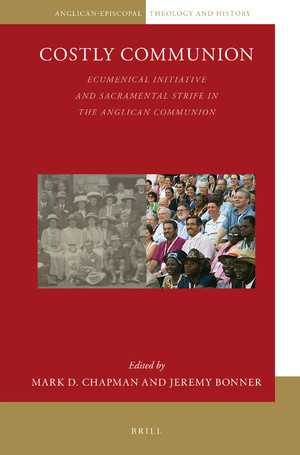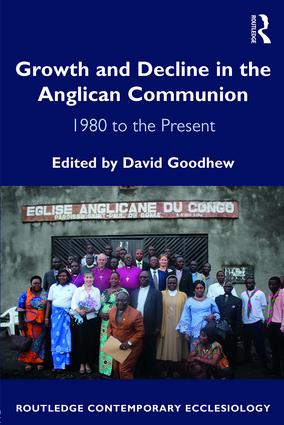This is the first of three articles that will appear in TRINITY, the diocesan publication of the Episcopal Diocese of Pittsburgh. They represent an overview of a manuscript history, which will be published by Wipf and Stock in 2009.
“At the noise of the trumpets he saith, Aha!” declares the Psalmist, “and he smelleth the battle afar off, the thunder of the captains, and the shouting.” From the 1758 expedition of General Forbes (an observant member of the Church of England) that won western Pennsylvania for the British Empire to the global storm now threatening to close the present chapter of the Anglican experience, western Pennsylvania has been witness to many of the profound changes that have reshaped this continent and the world. Now is the moment to pause and consider what it has meant to be Episcopalian and Anglican in Pittsburgh and its environs across two and a half centuries. In future articles I intend to look more closely at the nature of the shepherds called to guard the flock – our bishops – and at that much debated question of what being Anglican has meant to western Pennsylvanians down the years. As a preliminary, I propose to sketch some of the threads, both well-known and obscure, which constitute the web of the Episcopal experience since the foundation of the American Republic.
Isolation and neglect are recurrent themes of the western Pennsylvania experience, easily understood in an age when the region constituted the edge of frontier settlement, but no less applicable in the early nineteenth century when all roads led to Philadelphia or during the early 1980s when the Rust Belt recession left many Mon Valley communities fighting to survive. Thus could western Pennsylvania’s pioneer missionary, Joseph Doddridge, complain that little thought had been given to the needs of Episcopalians in scattered communities along the frontier in the 1790s and 1800s. Half a century later, in 1865, the region’s congregations were only too keen to cast off their ties to the settled east and form a new diocese stretching from Erie to Waynesburg. For them, east was east and west was better. Another forty-five years and the complaint went up that the northwest had little interest in the work of greater Pittsburgh, leading a committee to quip that a north-south division “would make practically no change in the conduct of affairs of the Diocese of Pittsburgh.” With such a ringing endorsement was the Diocese of Erie (now Northwestern Pennsylvania) birthed. Nevertheless, such isolation could also be challenged. Witness the work of Keith Ackerman (now Bishop of Quincy but then rector of St. Mary’s, Charleroi) when he brokered an agreement in 1984 to keep open a local foundry threatened with closure or the participation of Pittsburgh parishes in the New Vineyards Project of the 1980s, by which churches in areas of economic growth worked with those in depressed areas to relocate workers with appropriate skills. And who can forget that throng from “every tribe, people, language and nation” that gathered in Pittsburgh for Hope and a Future in 2005?
What then of class, that bugbear of Episcopal identity? In a Presbyterian town, the natural social ascendancy of Pittsburgh’s Episcopalians was somewhat dissipated, but not dramatically so. The identification of men like John Neville with the locally detested Federalist cause and his acceptance of the office of federal excise inspector, led to the burning of the Neville home during the 1794 Whiskey Rebellion. In the 1830s and 1840s several rising entrepreneurs identified as Episcopalians including John Harper, the first president of the Pittsburgh Clearing House, and Abraham Garrison, who launched the chilled roll industry in America. Yet what greater testimony can there be to the universality of the Christian message than the nine working class Confirmation candidates who walked twelve miles to attend the ceremony and then walked the same distance home in order to be at work the following day? Nor did demand among working class English immigrants slacken during the 1870s and 1880s, as the formation of the Layman’s Missionary League in 1889 attests. Most of those native to the Diocese will recall the missionary initiatives of the 1990s: Cursillo, the creation of “equipping ministries” like Robinson Township’s Incarnation Fellowship; the “6 in 96” program; and the implementation of “total ministry” at Aliquippa and Donora. A century earlier, however, the evangelists of the Layman’s Missionary League were out serving the English and Welsh miners who had no opportunity to come to the city for worship. The campaign against pew rents was but another marker on the road to social equality within the Body of Christ.
And what of healing, of care for the last, the lost and the least? Today we celebrate the self-denying work of Seeds of Hope and Shepherd’s Heart, missionaries to those “poor in things but rich in soul,” to invert the words of Harry Emerson Fosdick’s famous hymn. The depression of the 1980s is not so long past that we can forget the food cooperative established by St. Matthew’s, Homestead, a forerunner of many parish hunger ministries in the Diocese, yet these in turn were preceded by congregational initiatives during the 1930s to hire unemployed members to refurbish their facilities. “The Christian citizen’s attitude toward various schemes of relief that are proposed,” Bishop Alexander Mann warned at the time, “must be determined, not by the politician’s concern for votes, nor by the selfish fear of increased taxes, but by the unforgettable words of Jesus Christ – ‘I was hungry and ye gave me meat, I was naked and ye clothed me.’ ” Yet healing has a still more ancient lineage. Take the case of Alfred Arundel, who sought to make wealthy Trinity Church a haven for the residents of nearby tenements. “I went into this downtown district of our parish to fill the empty pews,” Arundel declared in his farewell sermon of 1911, “among underpaid and underfed laborers, in the slums and the tenderloin, I saw the results of extortionate capitalism – the undue enrichment of the few and the underserved poverty of the many.” There was another side to those wealthy capitalists whom Arundel was fond of flaying, however. Trinity’s John Shoenberger left most of his fortune to the erection of a public hospital – St. Mary’s Memorial – which remains part of the fabric of Pittsburgh’s public health system.
What, finally, of Pittsburgh’s Episcopalians in the public sphere? Consider the cases of William Baum and George Whitten Jackson, Evangelical Episcopalians and abolitionists, who helped found the Republican Party in Pittsburgh. Or George Hodges of Calvary who was instrumental in the establishment of Pittsburgh’s first settlement house – Kingsley House – and whose lay protégés, Henry D. W. English and George Guthrie, championed civic reform and sponsored the Pittsburgh Survey, one of the most extensive studies of social problems of the early twentieth century. How can one read Sam Shoemaker’s Pittsburgh Experiment as anything less than a call for Christians to integrate their spiritual and material lives? The earliest stirrings of civil rights activism can be seen in Walter Righter’s decision to admit an African American couple to All Saints Church in segregated Aliquippa and in the 1964 initiative of St. Stephen’s, Sewickley to sponsor a mission to the Hill District. For all those who struggled with such issues, the words of Nancy Chalfant, reflecting on the sorrow and the joy of raising a handicapped daughter, ring true: “I saw that I could be a channel through which that power could work, and I didn’t have to sit by helplessly as [my daughter] grew in years but not in mentality. Jesus became real to me, no longer a shadowy figure living 2,000 years ago but a person to love and be loved now, today, a person who loved [my daughter], too, and who hurt when we hurt.”
Today it seems as if we stand at a moment of superlative crisis, yet it was ever thus. “Had we imitated at an early period the example of other societies;” lamented western Pennsylvania’s pioneer missionary, Joseph Doddridge, to Bishop John Hobart in 1816, “employed the same means for collecting our people into societies, and building churches, and with the same zeal, we should have had by this time, four or five Bishops, surrounded by a numerous and respectable body of Clergy, instead of having our very names connected with a fallen Church.” Almost seventy years later, as Bishop Cortlandt Whitehead prepared to take up the reins he was faced with equally gloomy forecasts. “A spirit of Congregationalism pervades the whole diocese,” declared one correspondent. “There is not much going on of any sort; the diocese, the clergy and laity alike, are dead spiritually and this seems to be generally admitted.” The frontier is different – no longer geographical but ontological – yet the challenge and the promise remain the same. That frontier, Bishop Duncan declared in 2000, “is post-modern America: where political candidates no longer explain themselves by identification with a party heritage or tradition, where truth is relative and subjective and experiential, where conflicts are settled by guns and arguments by excommunication (whether of distance or divorce), where plenty and pain abound, and where everyone secretly yearns for some relationship or meaning that might hold beyond tomorrow.”









